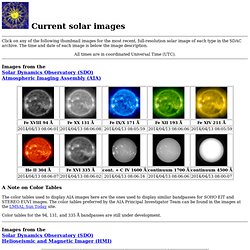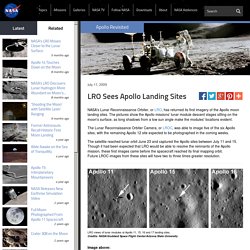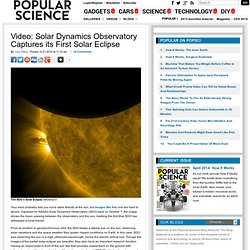

Averted Imagination. Ridiculously awesome pic of Discovery and the ISS taken from the ground! Astronomy Picture of the Day Archive. Astronomy Picture of the Day. PIA08391.jpg (JPEG Image, 1010x736 pixels) Amazingly well-timed photos of ISS silhouetted against moon, sun @Makezine.com blog.
Both these remarkable images were captured from the ground by French astrophotographer Thierry Legault.

The first, showing the ISS passing in front of the full moon, was taken from Avranches, France, at 21:34 UTC on December 20, 2010. The space station, of course, is much closer to the camera than the moon is, and is moving at 7.5 km/s relative to the ground, the upshot of which is that this photograph was only possible for the 0.55 seconds it took the ISS to pass in front of the moon.
Monsieur Legault knew that, in advance, planned for it, and got the shot. The second, even more remarkable photograph, shows a double partial eclipse of the sun, most obviously by the moon, to lower left, but also, again, by the ISS. The small dark spot to lower right is a sun spot larger than the Earth itself. M. More: Related. Solar images at SDAC. Click on any of the following thumbnail images for the most recent, full-resolution solar image of each type in the SDAC archive.

The time and date of each image is below the image description. All times are in coordinated Universal Time (UTC). Images from the Solar Dynamics Observatory (SDO) Atmospheric Imaging Assembly (AIA) A Note on Color Tables The color tables used to display AIA images here are the ones used to display similar bandpasses for SOHO EIT and STEREO EUVI images. Color tables for the 94, 131, and 335 Å bandpasses are still under development. Images from the Solar Dynamics Observatory (SDO) Helioseismic and Magnetic Imager (HMI) Images from other sources. Solar and Heliospheric Observatory Homepage. High Resolution Imaging Science Experiment. HSF Space Shuttle Gallery. Apollo Image Archive. Images: A 3D view of Endeavour. Human Space Flight Gallery. Zoom in to Opportunity Landing Site on Mars. LRO Sees Apollo Landing Sites. Apollo astronauts participate in a July 21, 2014 panel discussion held for employees at NASA's Kennedy Space Center.

From left are center director Bob Cabana, Apollo 8 and Apollo 13 crew member Jim Lovell, Apollo 11 moonwalker Buzz Aldrin, Apollo 11 command module pilot Mike Collins and NASA Administrator Charles Bolden. Cabana and Bolden, both shuttle astronauts, posed the questions to which the panel members responded. Credits: NASA/Kim Shiflett As Mike Collins remains in lunar orbit, some thought he might be the most lonesome person in the universe "Actually, I was so glad to get behind the moon so Mission Control would shut up.
Then I had some peace and quiet," Collins joked. Credits: NASA Apollo 11 lifts off from the Kennedy Space Center on July 16, 1969. "I was in the control center watching everything," Jim Lovell said. Credits: NASA/Neil Armstrong Apollo 11 astronaut Buzz Aldrin works at the deployed Passive Seismic Experiment Package on July 20, 1969. HSF Space Shuttle Gallery. Map of Mars Reconnaissance Orbiter (MRO) Context Camera (CTX) Images. Video: Solar Dynamics Observatory Captures its First Solar Eclipse. Your mom probably told you not to stare directly at the sun, but images like this one are hard to ignore.

Captured by NASA's Solar Dynamics Observatory (SDO) back on October 7, the image shows the moon passing between the observatory and the sun, marking the first time SDO has witnessed a lunar transit. From its position in geosynchronous orbit, the SDO keeps a steady eye on the sun, observing solar variations and the space weather they spawn impact conditions on Earth. In this case, SDO was observing the sun in a high ultraviolet wavelength, hence the electric yellow hue. Though the images of the partial solar eclipse are beautiful, they also have an important research function. Having an object pass in front of the sun like that provides researchers on the ground with information about the characteristics of the instruments aboard SDO.
As if the still image wasn't enough, SDO researchers also strung together the video clip below for your viewing pleasure.